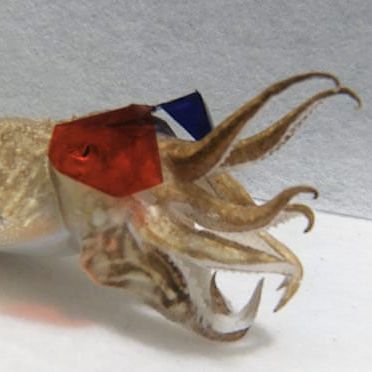
When I first saw this image of an ambiguous sea creature wearing 3-D glasses I had to do a double-take. Were studios already promoting Uncut Gems 2? Was this shrimp/slug thing trying to watch an Avengers movie? And how did the internet acquire exclusive images of me reading in bed after I’ve taken out my contact lenses?
In fact, what I was seeing is a cuttlefish, a kind of marine mollusk not typically found in a movie theater — another ill science has remedied, thanks to a team of researchers from the University of Minnesota who published their findings in Science Advances on Wednesday. According to The Guardian, the team, led by Dr. Trevor Wardill, put 3-D glasses on cuttlefish and played movies for them underwater in order to ascertain how the animals judge distance, specifically whether they are capable of a process called stereopsis, whereby visual stimuli captured by two eyes produces depth perception. (Humans do this, for instance.)
“A lot of people said it wasn’t going to work,” Wardill told The Guardian, surprising no one. “They said they’d rip the glasses off. They said there’d be ink in the tank.” A lot of people were sort of right. Gluing the glasses to the cuttlefish heads resulted in 3-D glasses set at “jaunty angles,” and the subjects often tried to rip the headgear off with their eight arms, causing skin damage. Wrap-around glasses didn’t work either — apparently they’d stay on, but not if the cuttlefish swam backward, which they are prone to doing. The researchers switched to Velcro.
For their subjects’ viewing pleasure the scientists decided to screen moving images of shrimp, which cuttlefish like to eat. The researchers concluded from these studies that cuttlefish do indeed use stereopsis. Wardill said of the team’s methods and results, “If you have the images a long way apart, the cuttlefish think the shrimp is really close and they back up and try to shoot their tentacles right in front of them. But if you flip the images around and make the shrimp look like it’s behind the screen, they’ll swim right into it.”
In conclusion, nothing about this study isn’t clownishly humorous.

